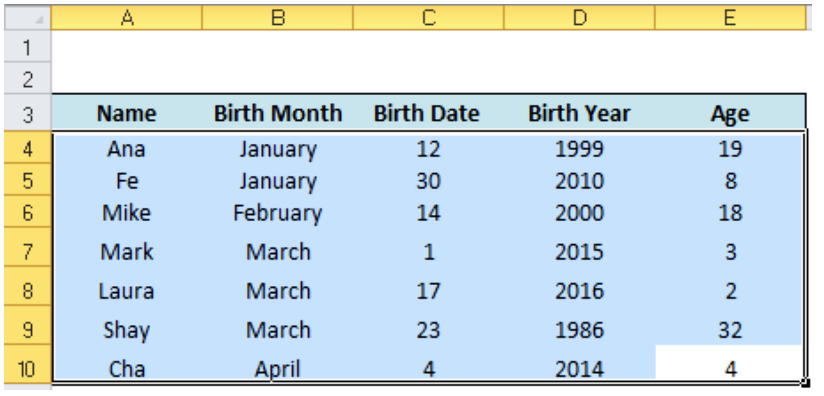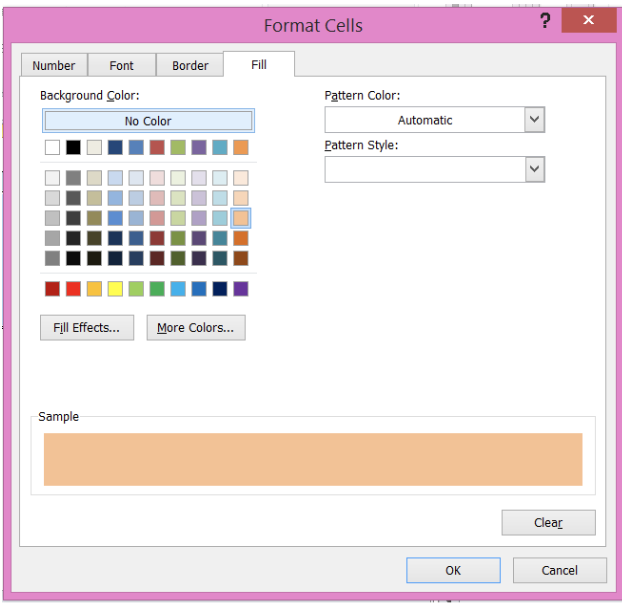Conditional Formatting is a feature in Excel that allows us to change the format of cells based on a set of rules or conditions. Conditional formatting can be applied to a set of selected cells, including an entire row. This step by step tutorial will assist all levels of Excel users in applying conditional formatting to an entire row.

Figure 1. Applying conditional formatting to an entire row
Setting up the Data
Suppose we have the sample data below. We want to highlight the people that are below 18 years of age and apply the format to not just the “Age” column but to the entire row.
 Figure 2. Sample data for conditional formatting to an entire row
Figure 2. Sample data for conditional formatting to an entire row
Applying Conditional Formatting to an Entire Row
We can do this in 4 easy steps:
- Step 1. Select the rows to be formatted. In this case, select cells A4:E10.
 Figure 3. Selection of the data range for conditional formatting
Figure 3. Selection of the data range for conditional formatting
- Step 2. Click the Home tab, then the Conditional Formatting Menu and select “New Rule”. The New Formatting Rule dialog box will pop up.
 Figure 4. Creation of a new rule in conditional formatting
Figure 4. Creation of a new rule in conditional formatting
- Step 3. Select the Rule Type “Use a formula to determine which cells to format” and enter this formula in the dialog box :
=$E4<18
Important Note: Add the dollar sign “$” before the column E to fix the column that we use as reference for the conditional formatting.
The formula =$E4<18 serves as the condition or rule that will trigger the conditional formatting. For every row of data, if the “Age” is less than 18, the format will be changed.
 Figure 5. Entering the formula as a condition or formatting rule
Figure 5. Entering the formula as a condition or formatting rule
How will the format change? Let us proceed to the next step.
- Step 4. Click “Format” and then decide on what will be the new format to apply to the entire row. We can change the font, borders or fill the cells with different colors.
Example
Select “Fill” and choose Orange, Accent 6, Lighter 40% and click OK.
 Figure 6. Selection of the format to use
Figure 6. Selection of the format to use
 Figure 7. Completion of the new formatting rule with formula and selected format
Figure 7. Completion of the new formatting rule with formula and selected format
This rule highlights the entire rows of data that satisfy the condition of Age < 18.
 Figure 8. Output: New conditional formatting rule reflected in the entire row of data
Figure 8. Output: New conditional formatting rule reflected in the entire row of data
As shown, we are able to change the format of the entire rows with ages less than 18.
With Conditional Formatting, the options are endless. We can customize the format of the cells to our preference, based on the rules we provide.
Most of the time, the problem you will need to solve will be more complex than a simple application of a formula or function. If you want to save hours of research and frustration, try our live Excelchat service! Our Excel Experts are available 24/7 to answer any Excel question you may have. We guarantee a connection within 30 seconds and a customized solution within 20 minutes.














Leave a Comment